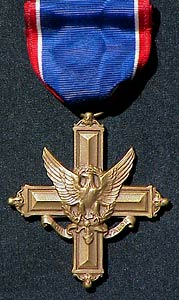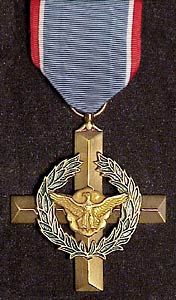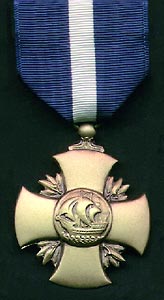|
 Distinguished
Service Cross Distinguished
Service Cross
The Distinguished Service Cross was
established by order of President Woodrow Wilson, as promulgated in War
Department General Orders Number 6 of January 12, 1918, and formalized
by Act of Congress on July 9, 1918 (Public Law 193, 65th Congress).
The Distinguished Service Cross has been
in effect since April 6, 1917; however, under certain circumstances the
Distinguished Service Cross may be awarded for services rendered prior
to April 6, 1917.
Criteria
The Distinguished Service Cross may be awarded to a person who, while
serving in any capacity with the Army, distinguishes himself by
extraordinary heroism not justifying the award of a Medal of
Honor. This extraordinary heroism must take place while the
individual is engaged in an action against an enemy of the United
States; or while he is engaged in military operations involving conflict
with an opposing foreign force; or while he is serving with friendly
foreign forces that are engaged in an armed conflict against an opposing
armed force in which the United States in not a belligerent party.
The act or acts of heroism must be so notable and involve risk of life
so extraordinary as to set the individual apart from his comrades.
Order of Precedence
The Distinguished Service Cross is worn after the Medal of Honor and
before all other decorations. Additional awards are denoted by oak
leaf clusters.
Designers
The Distinguished Service Cross was designed by First Lieutenant
Andre Smith and modified by Captain Aymar Embry, both of the Camouflage
Section, 40th Engineers, at Camp American University. Embry's
final design was sculpted by John R. Sinnock of the Philadelphia Mint.
First Recipients
The first awards of the Distinguished
Service Cross were made on March 18, 1918, to three soldiers from the
1st Division; Second Lieutenant John N. Green of the 6th Field Artillery
and to Sergeant William M. Norton and Private Patrick Walsh, both of
Company I, 18th Infantry.
Description and Symbolism of the
Second (Current) Style Distinguished Service Cross
Obverse
The second style Distinguished Service Cross is a modification of
the first style; it has a sculptured inner cross mounted on a flat cross
with decorative, fluted edges. At the end of each arm is a small
ornamental scroll topped by a ball. An eagle with displayed wings
is centered on the cross and behind the eagle is a circular wreath of
laurel (which replaces the diamond in the first style cross). The
laurel wreath is tied at its base by a scroll which extends into the
lower re-entrant angles of the cross and contains, FOR
VALOR.
Reverse
The reverse also features a sculptured inner cross on a flat cross,
with the same decorations at the edges that appear on the obverse.
The back and tips of the eagles wings are also shown. Centered
upon the cross is a circular wreath of laurel with a bowknot at the
bottom from which flows the back of the scroll, joining the arms of the
cross. In the center of the wreath is a rectangular plaque with
decorative edges, which is blank for engraving the recipient's name.
Ribbon
The ribbon was designed by Captain Andre Smith and has a central
field of blue (one inch wide) edged in white and red, with the red
forming the outermost colors of the ribbon. The colors of the
ribbon are those of the flag and stand for purity (white), sacrifice
(red), and high purpose (blue).
 Air Force Cross
Air Force Cross
The
Air Force Cross was originally established by Act of Congress (Public
Law 193, 65th Congress approved July 9, 1918) as the Distinguished
Service Cross. Public Law 86-593, approved by Congress on July 6,
1960, amended Title 10 of the United States Code by authorizing the Air
Force to present a distinctive version of the Distinguished Service
Cross to Air Force recipients. The
effective date of the Air Force Cross is July 6, 1960; however, awards
based on earlier actions may be made after that date if the
recommendations for them have not been acted on or have been lost.
Criteria
The Air Force Cross is the second highest decoration awarded by the
Air Force and is given for extraordinary heroism not justifying the
award of a Medal of Honor. It may be awarded to any person who,
while serving in any capacity with the U.S. Air Force, distinguished
himself by extraordinary heroism (1) in action against an enemy of the
United States; (2) while engaged in military operations involving
conflict with an opposing foreign force; or, (3) while serving with
friendly foreign forces engaged in an armed conflict against an opposing
armed force in which the United States is not a belligerent party.
Like the Distinguished Service Cross, the Air Force Cross is presented
in the name of the President, although the Air Force itself actually
controls this award.
Order of
Precedence
The Air Force Cross is worn after the Medal of Honor and before all
other decorations. Additional awards of the Air Force Cross are
denoted by Oak Leaf Clusters. Designer
The Air Force Cross was designed by Eleanor Cox and sculpted by
Thomas Hudson Jones, both of the Army's Institute of Heraldry. First
Recipient
The first Air Force Cross was awarded posthumously to Major Rudolf
Anderson, Jr. for service during the Cuban Missile Crisis. Description
and Symbolism Obverse
A bronze cross with an oxidized satin finish. Centered on the
cross is a gold-plated American bald eagle, wings displayed against a
cloud formation encircled by a laurel wreath finished in green
enamel. The design is based on that of the Distinguished Service
Cross; the eagle and cloud formation are taken from the seal of the Air
Force. Reverse
The reverse of the Air Force Cross is blank for engraving the
recipient's name. Ribbon
The ribbon to the Air Force Cross is the same as that of the
Distinguished Service Cross, except the central shade of blue is lighter
(to distinguish it from the Distinguished Service Cross).
 Navy
Cross Navy
Cross
The Navy Cross was
established by Act of Congress (Public Law 253, 65th Congress), approved
on February 4, 1919. The Navy Cross
has been in effect since April 6, 1917. Criteria
The Navy Cross may be awarded to any person who, while serving with
the Navy or Marine Corps, distinguishes himself in action by
extraordinary heroism not justifying an award of the Medal of
Honor. The action must take place under one of three
circumstances: while engaged in action against an enemy of the United
States; while engaged in military operations involving conflict with an
opposing foreign force; or, while serving with friendly foreign forces
engaged in an armed conflict in which the United States is not a
belligerent party. To earn a Navy Cross the act to be commended
must be performed in the presence of great danger or at great personal
risk and must be performed in such a manner as to render the individual
highly conspicuous among others of equal grade, rate, experience, or
position of responsibility. An accumulation of minor acts of
heroism does not justify an award of the Navy Cross. Order
of Precedence
The Navy Cross is worn after the Medal of Honor and before all other
decorations. Additional awards of the Navy Cross are denoted by
gold stars five-sixteenths of an inch in diameter. Designer
The Navy Cross was designed by James Earl Fraser (1876-1953). First
Recipient
The first actual recipient of the Navy Cross is unknown because
initial awards were made from a lengthy list published after the First
World War. Description and
Symbolism Obverse
The Navy Cross is a modified cross patée one and a half inches wide
(the ends of its arms are rounded whereas a conventional cross patée
has arms that are straight on the end). There are four laurel
leaves with berries in each of the re-entrant arms of the cross.
In the center of the cross a sailing vessel is depicted on waves,
sailing to the viewer's left. The vessel is a symbolic caravel of
the type used between 1480 and 1500. Fraser selected the caravel
because it was a symbol often used by the Naval Academy and because it
represented both naval service and the tradition of the sea. The
laurel leaves with berries refer to achievement. Reverse
In the center of a bronze cross patée one and a half inches wide,
crossed anchors from the pre-1850 period, with cables attached.
The letters USN appear
amid the anchors. Ribbon
The ribbon is navy blue with a center stripe of white, the blue
alludes to Navy service and the white represents the purity of
selflessness.
 Distinguished
Flying Cross Distinguished
Flying Cross
The Distinguished
Flying Cross was established by Act of Congress (Public Law 446, 69th
Congress), approved July 2, 1926, and implemented by Executive Order
4576 signed by President Calvin Coolidge on January 28, 1927. This
law was amended by Section 4 of Public Law 234 (approved on July 30,
1937) to permit the Coast Guard to award the Distinguished Flying Cross
in its own right (members of the Coast Guard could previously receive
the Distinguished Flying Cross only "while serving with the
military or naval forces"). Public Law 234 was implemented by
Executive Order 7786 signed by President Franklin D. Roosevelt on
January 8, 1938. The Distinguished
Flying Cross has been in effect since July 3, 1927. However,
Executive Order 4601 signed by President Hoover on March 1, 1927,
provided that for "any act of heroism or extraordinary achievement
performed on or before July 2, 1926, the Distinguished Flying Cross
shall not be awarded after July 2, 1929, nor unless the recommendation
therefore shall have been made on or before July 2, 1928." Criteria
The Distinguished Flying Cross may be awarded to military members
who, while serving in any capacity with the Armed Forces, distinguish
themselves by heroism or outstanding achievement while participating in
aerial flight. To be awarded for heroism the act must involve
voluntary action in the face of danger and be well above the actions
performed by others engaged in similar flight operations. If
awarded for extraordinary and outstanding as to clearly set the
individual apart from his or her comrades or from other persons in
similar circumstances. Awards of the Distinguished Flying Cross by
the Army are only made to recognize single acts of heroism or
extraordinary achievement and not to recognize sustained operational
activities against an armed enemy. Order
of Precedence
The Distinguished Flying Cross is worn after the Legion of Merit and
before the Soldier's Medal, Navy and Marine Corps Medal, Airman's Medal,
or Coast Guard Medal. Additional awards are denoted by oak leaf
clusters (Army and Air Force). Additional awards are denoted by
gold stars five-sixteenths of an inch in diameter, and the Combat
Distinguishing Device may be authorized for qualifying service rendered
after April 4, 1974. Designer
The Distinguished Flying Cross was designed by Arthur E. DuBois and
Elizabeth Will, both of the Army's Institute of Heraldry. First
Recipient
The first recipient of the Distinguished Flying Cross was Captain
(U.S. Army Reserve) Charles A. Lindbergh, who received medal number 1 on
June 11, 1927, from President Calvin Coolidge in a special ceremony on
the grounds of the Washington Monument. However, the earliest act
for which a Distinguished Flying Cross was awarded occurred much
earlier. By Act of Congress (Private Law 313) approved December
18, 1928, Wilbur and Orville Wright were awarded the Distinguished
Flying Cross for the first manned flight at Kitty Hawk, North Carolina
on December 17, 1903. Description
and Symbolism Obverse
On a bronze cross pattee one and a half inches across, a four-bladed
propeller one and eleven-sixteenths inches across the blades; in the
re-entrant angles, rays forming a one inch square. The cross is
suspended by a plain, straight suspender. Reverse
The reverse is blank, leaving space for engraving the recipient's
name. Ribbon
The ribbon is predominantly blue, with a narrow band of red bordered
by white in the center. The edges of the ribbon are outlined with
equal bands of white inside blue.
|
 Distinguished
Service Cross
Distinguished
Service Cross Air Force Cross
Air Force Cross Navy
Cross
Navy
Cross Distinguished
Flying Cross
Distinguished
Flying Cross